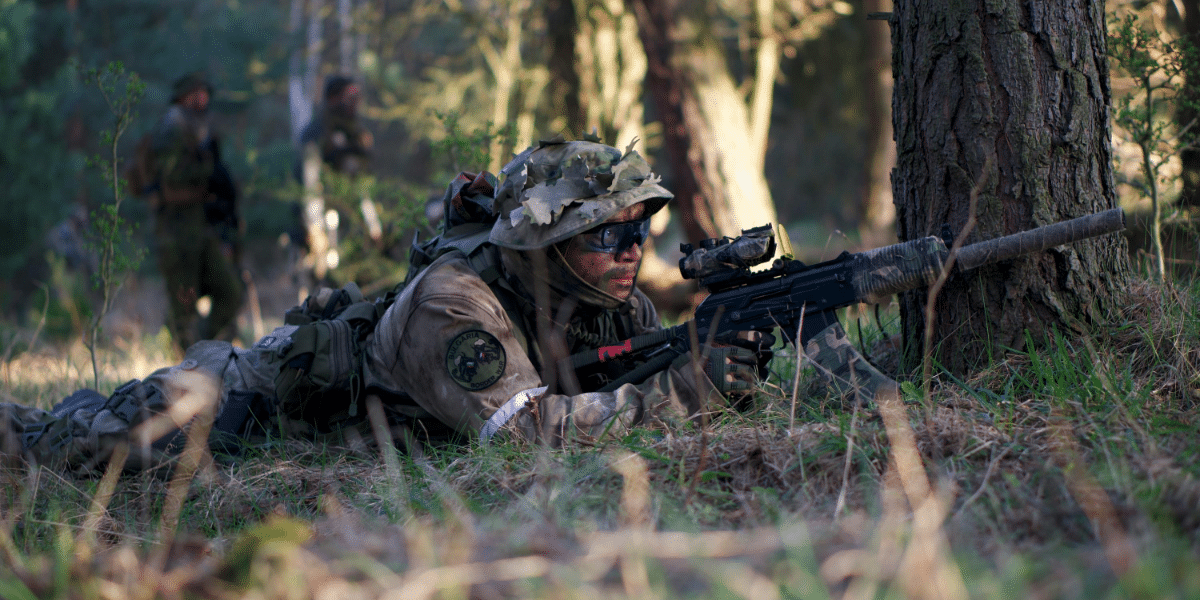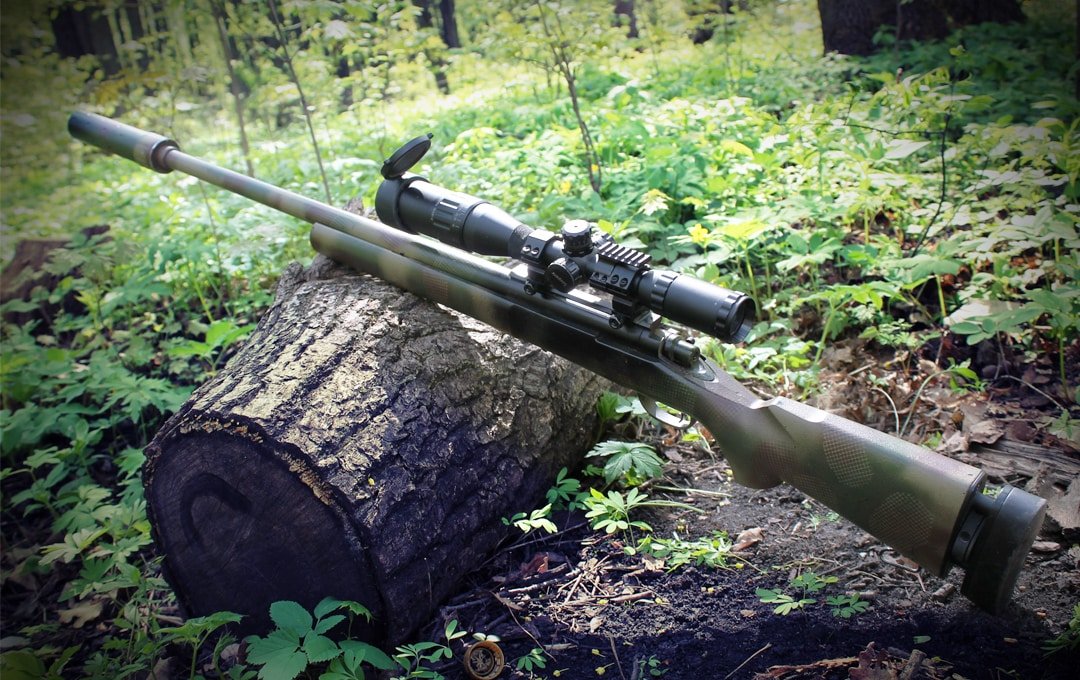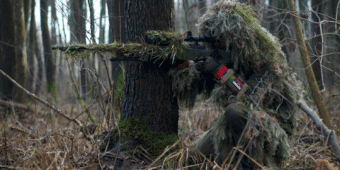If you’re interested in being a sniper, you’ve come to the right place. Whether you want to apply sniper methods in everyday life to become a better version of yourself, to become a better hunter or even for airsoft milsim war simulations, you should read this article to the end because it contains a lot of information. Let’s break down the crucial points of being a successful sniper:
- How do they use their gear?
- How do they stay undetected and deal with the limitations of the human body?
- The process of sniper shooting from A to Z?
Snipers work in pairs, with specialized equipment and very advanced work methods. They are trained to be real killers and are able to accomplish their objectives even under extreme pressure.
Let’s start now with the basics of the trade by breaking down the use of a sniper rifle as it is in our time. Let’s see what caliber snipers use!
What caliber do snipers use?

There are many armies around the world, and each army uses its own caliber respectively. Within these armies or military forces, you can imagine that not all sniper units use the same caliber!
So we will make generalizations about this recurring question. Without a doubt, the most common caliber used by conventional sniper units is the 7.62mm. There are many variations depending on the country, we will find for example:
- 7.62×54 mm R in the Russian and Belarusian armies, widely used with the Dragunov and its civilian variant the Tiger: this is a rimmed rifle cartridge that was developed by the Russian Empire before the Bolshevik revolution. It is also used in light machine guns such as the PKM or the PKP Pecheneg.
- 7.62×51mm NATO in America and the European countries that are part of the NATO program (there are many of them). It’s a rimless bottlenecked rifle cartridge developed in the 1950s after WW2. The first rifle to use this caliber was the M14. Today we note its use with the FN Scar, the M40 sniper, the M24, the Blaser R93 Tactical, the T93 sniper rifle… The list is long.
Among sniper rifles, we also find the use of larger calibers offering a higher probability of hitting a target on impact. The .300 Winchester Magnum and the .338 Lapua Magnum are popular for this type of operation. The use of anti-material cartridges also allows to reach about the same performance: the 12,7 mm, the 14,5mm or even the .50 caliber allows the snipers a slightly larger margin of error, and the possibility to shoot faster in front of imminent danger.
Even with a large caliber, if the sniper does not know how to calculate the distance to his target and quickly take into account multiple variables that influence ballistics, he will only be able to miss his target. So let’s see what calculations snipers use to make surgical shots.

The 7.62×51mm NATO Bolt Action Sniper M24 
The 7.62×54 mm R Semi Automatic Sniper SVD Dragunov
What calculations do snipers use?
To make a successful long-range shot, a professional sniper must take into account the natural elements that affect the bullet’s trajectory. Here they are:
- Gravity: This is the most basic parameter to take into account. It is based on the distance the sniper is from the target, but also takes into account the terrain: shooting from the top of a cliff to a target below does not give the same result as shooting from the bottom of the cliff to its target.
- Wind: Every day, every hour and even every minute is different. The wind is one of these very volatile parameters to take into account. A simple gust of wind can deflect the ball from its target over a very long distance. For this it is imperative for the sniper to work with his partner.
- Temperature, humidity and altitude: More secondary, these parameters also have an influence on the trajectory of a ball at very long distance.
- The rotation of the earth: Reserved for the most incredible shots, this parameter is actually only taken into account for world record attempts. A soldier’s objective is to neutralize his target, not to break distance records. If a very long distance is a prerequisite to eliminate the target in all discretion, then the sniper may have to take into account the rotation of the earth to succeed in his shot.
Today these parameters are taken into account by software, in which the necessary mathematical formulas are integrated. All that is left to do is to enter variables such as distance from the target, wind speed, humidity and temperature and these tools will indicate how to adjust the scope for a successful shot.
Now we come to the zero adjustment of the sniper’s scope, let’s discover together how it is possible to do it manually without the help of these applications.

How do Snipers zero their rifles?
As a professional, a sniper must know his sniper rifle perfectly. When on a mission, his scope must be adjusted without firing even once. Otherwise, he will lose his position undercover and be forced to pack up, which could end very badly.
Knowing their weapon and its behavior with all types of ammunition is essential. That’s why they shoot a lot in training: to record data on their weapon according to the shooting conditions. Thus, the zero adjustment of his scope will be greatly facilitated. US snipers have a DOPE (Data On Previous Egagment) card for this.
In the field, the sniper will have all the necessary data to adjust his scope, which he will have to cross with the actual circumstances during the shooting: distance, wind strength, type of ammunition, weather. The sniper’s partner is in charge of collecting this information, while the sniper is in charge of matching it with his rifle.
But there’s more to a sniper’s job than that. Effective shooting cannot take place without good camouflage, and he will sometimes be forced to take up waiting positions for very long hours. Let’s see how snipers manage to stay invisible.
How do snipers stay hidden?
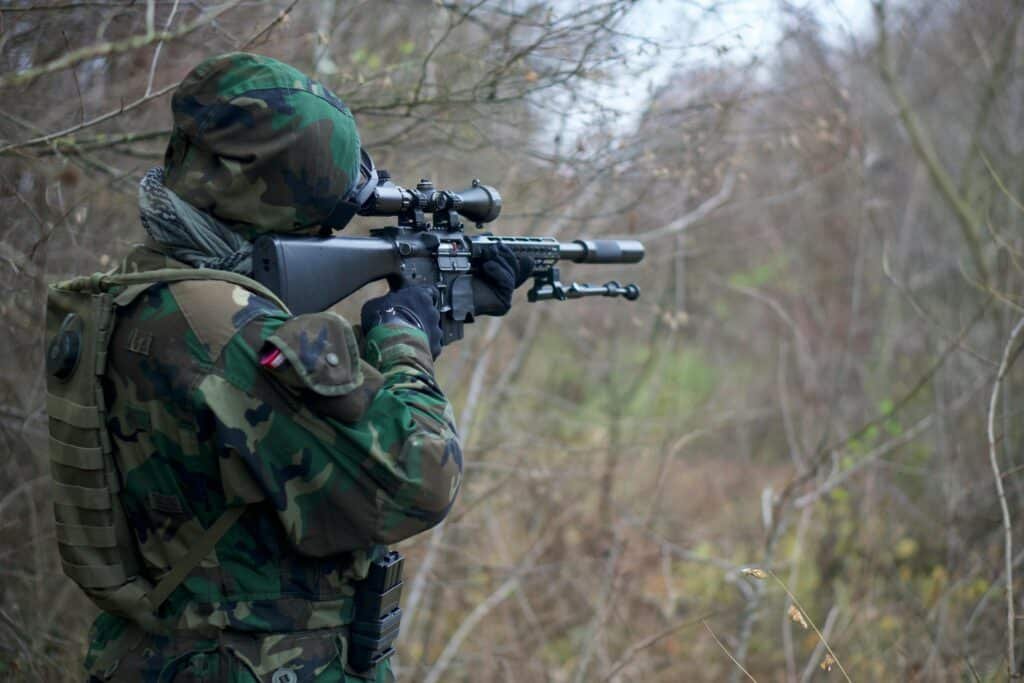
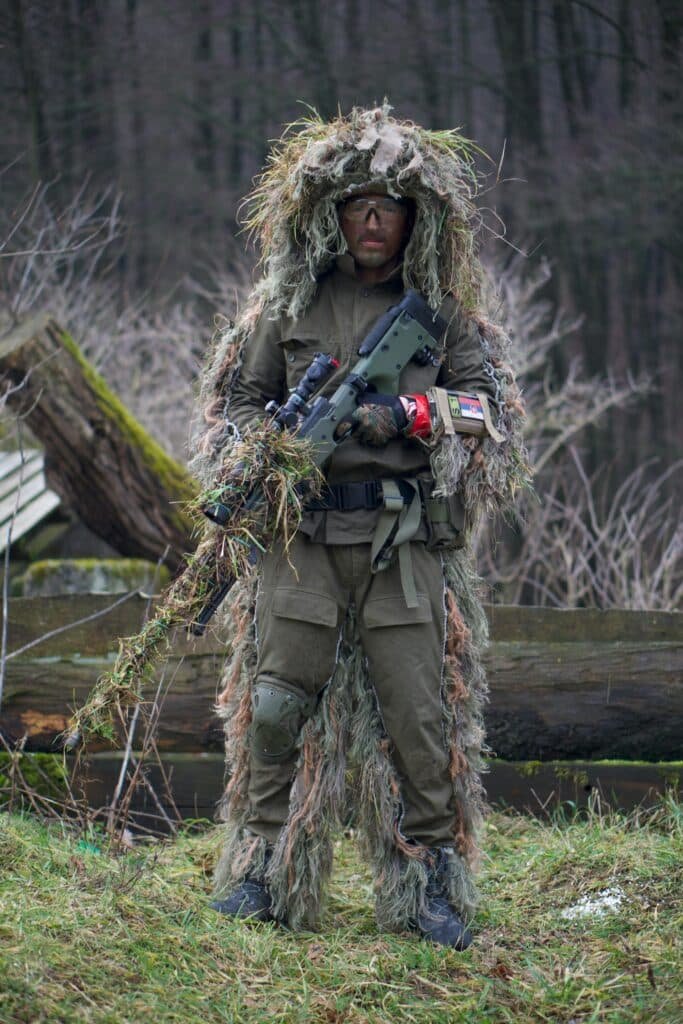
The art of camouflage is an indispensable skill for snipers. Once they have secured their position, they have to prepare for long periods of waiting before preparing their firing position. This is a crucial phase for any remote elimination mission, as the slightest movement or camouflage error could compromise the position of the pair and lead to the cancellation of their mission. Snipers from receive training to evade surveillance from enemies at their vantage points, as well as from patrols in the field. 360-degree concealment is the optimal camouflage for a sniper: the idea that an enemy stationed on the sniper’s flanks or even behind his back cannot spot him. The ideal is to escape detection by the enemy up to a distance of 1 meter.
Their training involves:
- Their movements: the closer the distance to the enemy, the more thoughtful the sniper’s movements must be. Slowly, he will be able to reach his firing position to eliminate his target. His calmness, determination and finesse will prevail.
- Their equipment: with the help of an effective camouflage, they will be able to remain undetected up to 1 meter from the enemy. It will be necessary to break its silouhette with elements of natural or not camouflage. The most important thing is to match the color spectrum of his camouflage and to break the shape of his human silhouette.
- Anticipation of enemy movements: thanks to his instinct, he must be able to foresee enemy movements and if necessary change his position to remain undetected.
Do snipers hide in trees?
In theory a sniper can camouflage himself wherever he wants, but his position in a tree would be very uncomfortable to wait for long. Soon he would be cramped and would have to change his cover quickly. Luckily, we have pictures of a hunter who likes adventure. We will see in the next section how fast a sniper shoots.
How fast do snipers shoot?
This chapter contains 2 answers. The first one is about the man himself: how long does it take a professional to shoot? This is a crucial moment because everything will depend on the sniper’s mission. If his objective is to reach a shooting point and wait for his target to come on the spot, he may have to wait up to 48 hours practically without moving, to have the best possible shooting window. In this case, the sniper faces several problems: he cannot stop his body, he is good, but he is still a simple human. We’ll see it more in detail in the next chapters about sleep and hygiene.
The second question concerns the sniper rifle itself, in other words its rate of fire. This will depend on its firing system. Semi-automatic sniper rifles such as the M110, the SVD Dragunov or the M21 (based on the M14), or the M14 EBR have a rate of fire of about 300 rounds per minute. Taking into account that they do not shoot in automatic but in semi-automatic, this is a very good average.
Bolt-action sniper rifles are much slower to re-arm. It takes about 1 shot every 2 seconds, or 30 shots/minute.
How do snipers stay awake?
The snipers’ missions can last several days. As snipers, their mission is to eliminate their target at the most opportune moment. But this is sometimes (often) preceded by very long observation phases. There are several techniques and ways to stay awake, I have established a listing of the most frequent ones below:
- Specialized training for professional snipers: through their repeated hard training and specialized learning of the trade, snipers develop skills that few people will ever have. They train their willpower like never before and can resist for a long time concepts that temporarily escape them such as boredom, physical pain or lack of sleep. If they have been given an order, they must follow it no matter what.
- Group work: The main advantage of working in pairs with an observer is the opportunity for the sniper to rotate with his partner to get away from his scope. In addition to missions that can last up to 72 hours (this is usually the time frame of a sniper’s operation), aiming at a fixed point with a sniper scope is extremely tiring. Therefore, it is essential to step away from the scope for a few moments and several times to avoid burning out completely.
- Food and drink: coffee, concentrated food such as energy bars and other ingredients can make a difference in the field by providing that necessary boost for a few extra hours.
- Drugs and medicines: during the Vietnam war, or during the Afghan war for the Soviets, it was very common to use medicated mixtures to prevent a soldier from falling asleep. It is also the most risky way to do it, because of the side effects. You can refer to this list of drugs used by the military to learn more.
“God sometimes grants sleep to the wicked so that the good may be at peace.” On this beautiful quote from Jean-François Saint-Lambert, let’s see how snipers manage to stay relatively clean on missions.
Do snipers poop themselves?
In short, it is possible. Only if it’s the last option in the sniper action panel, because it’s not comfortable, it leaves odors, and it’s really dirty. During a mission, the sniper will be brought to eat. It’s a good thing because he carries an MRE with him. And this MRE is wrapped in a plastic bag, again, it’s good timing. The sniper will be able to use it to shit in it with the help of his partner to leave no trace. Who said that the job of a sniper pair was only to observe? No more holywood glamour, this is the real job of a sniper. It’s a tough job, extremely difficult.
The idea here is to leave no trace behind, either for humans or animals (a dog will easily pick up the scent, and if the sniper has even dug a small hole to take a shit, the dog will pick it up). While not compromising their position, that’s why a sniper always has to wait until night for this.
Do Snipers keep both eyes open?

A question that often comes up regarding precision shooting concerns the use of one’s eyes: is it better to keep both eyes open when aiming or to close one, to concentrate on the objective only with the second?
It is a common belief that a sniper should close one eye for better aiming. This is true because the difference in magnification can be very high depending on the scope. This makes it easier to acquire a target that is extremely visible through the scope. Focusing on an inconspicuous detail, a small element in the field of your scope, is easier with one eye open than 2. It is therefore appropriate for the sniper to make a very long range shot with one eye closed. In principle.
Now, to talk more technically, let’s address the subject of pupil dilation and the existence of the “dominant shooting eye”. Because while this is true for very long range targets, it is not always optimal to shoot with an open eye. With both eyes open, instinctively, your dominant shooting eye (the one you are supposed to aim with), takes over your second eye. This way, you keep your field of view partially intact, while obtaining a magnification of the desired area. This is a much more restful mode of operation for long observations, and more pleasant for medium/long range shooting.
Combined with good heart rate control, good sniper aiming will make all the difference for ultra-precise shooting.
How do snipers control their heart rate?
It is possible for every healthy human being to control their heart rate. Top athletes are closely monitored by their trainers in this regard. I myself easily reach a heart rate of 60 beats per minute or less (up to 55). There is no secret to this, but here are some exercises that can make a difference:
- Work on your cardio: running or other physical exercises like swimming, hiking.
- Breathing exercises: help control your breath
- Control your emotions: your emotional state influences your heart rate
Such a skill allows the sniper to slow down his heart rate as much as possible, and to shoot at his target during 2 heartbeats. In this way, he maximizes his chances of success by avoiding any tremors during a heartbeat.
The last point being clearly linked to the learning of the sniper’s job, we will see in the following chapter how they do to stay in control of themselves in all circumstances.
How do snipers stay calm?
Sometimes a demonstration is worth more than words. It is through a deep understanding of their bodies, aided by specialized training, that a sniper is able to perform such feats. This translates into a great ability to keep one’s cool in the face of the different situations that surround them. Whether you believe it or not, we can all relax in a few moments. Let’s say you have a very important interview for your professional career: about thirty minutes before this interview, it is recommended to clear your mind. Do not think about anything, stay here and now without making any projections into the future. Fix your soul in the present moment, and help yourself with long, deep, relaxed breaths. You will then be able to lower your heart rate, and have clearer ideas by limiting the tunnel effect (loss of peripheral vision, confused ideas, psychological blockage).
Do Snipers hold their breath?
Each shooter is supposed to hold his breath before firing. Breathing is a process that prevents the maximum accuracy of a precision shot, due to the compression and expansion of the diaphragm. This causes the chest to move in a way that is very detrimental to the accuracy of the shot. The difference between a sniper’s breath-holding and a regular soldier’s breath-holding is the length of time they hold it. A sniper will hold his breath for up to ten seconds or so to reduce his tremors for as long as possible; this gives him time to find the best time to shoot, both tactically and to reduce his heart rate to a minimum and shoot between heartbeats.
During these few seconds, the sniper must be in a perfect position to make his shot. All he has to do is pull the trigger. Let’s see it right now.
Do Snipers go for headshots?
There are several types of sniper, each attached to their respective unit. If we take the Russian SOBR snipers as an example, they engage their target at a much lower range than snipers from other special forces working directly with the army. Army snipers, like those special units such as the SSO battle group, or the MVD airborne troops, engage their targets at ranges of up to about one kilometer. Police snipers are more likely to fire at distances of around 250 meters.
This difference in engagement distance explains the sniper’s aim: the farther away he is, the more likely he is to hit a larger area such as a man’s torso. Headshots are very rare, but do occur. They are mostly done in an urban environment, during operations requiring great precision, such as hostage-taking (the hostage-taker holds a policeman at gunpoint, with a hostage on the other arm as a human shield).
Where do Snipers aim for?

In order to guarantee an optimal result and to put all his chances on his side, the sniper will prefer to aim at the torso. This area is just as deadly as the head, and after the sniper’s bullet has hit his target, he will have no chance of survival. The victim will then take a few seconds to realize that his body is out of action. His physical death automatically follows.
This is particularly suitable for night shooting, which is more delicate. Let’s see it in the next chapter.
How do snipers shoot at night?
War has long ceased to be a noble chivalrous pastime, and true professionals prefer to leave the enemy with a minimum of chances, ideally zero. And the best time for them is at night. Especially when you can see the enemy and he can’t see you. Since World War II, the enemy has been targeted with night vision equipment. Today, it is increasingly through thermal imaging cameras.
War being what it is, I decided to put some pictures of the use of this type of scope in the field. The video shows a sniper from a Middle Eastern country. Impossible to identify with certainty if it is a Taliban or a local special forces soldier. The radar system seems to indicate that the video was shot by a Taliban. This also explains his amateurishness, he misses his target several times and shoots at very regular intervals.
What do snipers say before they shoot?
A professional will always have a connection with his teammates. However, at the moment of shooting the sniper does not say a word. Once he has the green light to fire, he fires without a word. Talking could disrupt his concentration, his heart rate, his breath, and therefore the shot.
Now you know all about sniper work. To camouflage yourself effectively, be sure to check out our category dedicated to sniper gear. You’ll find the essentials to make a camouflage worthy of the name.

Discover our gorka suits
The richest collection of authentic military gorka outfits. Find our classic khaki, camouflage, summer and winter windbreaker suits in Russian style.

